Scientists aim to restore oyster population

For the first time in a century, thousands of oysters once again populate a picturesque stretch of water in north Scotland as part of an ambitious project involving researchers from Heriot-Watt University.
Extensive fishing during the 1800's are thought to have decimated oyster populations in the Dornoch Firth, as they did throughout Europe, but an exciting new project supported by the whisky firm, Glenmorangie, aims to restore the marine habitat.
The Dornoch Environmental Enhancement Project (DEEP) was formed in 2014 as a partnership with Heriot-Watt University, Glenmorangie and the Marine Conservation Society, with the primary aim of reintroducing oysters to the area.
After establishing that the oysters were once there for thousands of years, the project placed 300 oysters into the protected waters last year to confirm whether or not the species could survive. Now, as part of the third phase, the team will recreate entire protected reefs where they have been lost, something that has never been attempted in Europe before.
Dr Bill Sanderson, Associate Professor of Marine Biodiversity at Heriot-Watt, is the Research Director of DEEP. His team trawled archaeological records, ancient literature and fisheries records, then sampled shell material to show that oysters had existed in the Dornoch Firth up to 10,000 years ago – and, importantly, determined that they could be reintroduced. He gave his reaction to the latest phase of the project, saying: “This is the first time anyone has tried to recreate a natural European oyster habitat in a protected area from scratch. Working with our partners, Glenmorangie and the Marine Conservation Society we hope to create an outstanding environment for marine life in the Firth – and act as a driving force behind other oyster regeneration work across Europe.”
20,000 oysters were carefully placed on the first of the new reefs, specially created from waste shell, to mimic their natural habitat. If successful, a further 200,000 of the creatures will be released over the next three years. It is hoped that over five years, the population will be built up to four million, spread over 40 hectares and restoring the self-sustaining oyster reefs that once existed in the Firth.
Hamish Torrie, Glenmorangie's CSR Director, said: ‘We are very excited to move DEEP to its next stage and have been hugely encouraged by the enthusiastic support that our meticulous, research-led approach has received from a wide range of Scottish Government agencies and native oyster growers – it is a truly collaborative effort. We are all very proud that in our 175th year the Distillery has such a pioneering environmental project right on its doorstep.”
The DEEP Project is the first attempt to restore the endangered Native European oyster to a protected area where it has become extinct.
Key information
Bill Sanderson
- Professor
- w.g.sanderson@hw.ac.uk